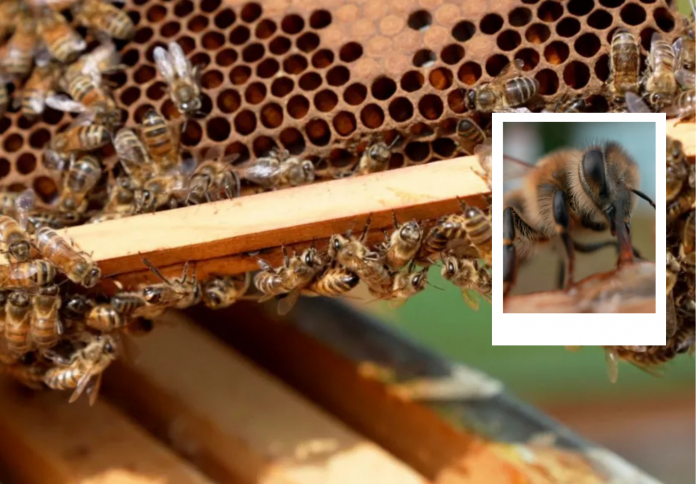In a groundbreaking achievement that could reshape the future of agriculture and conservation, a team of scientists has engineered a revolutionary honeybee “superfood” designed to fortify colonies against a host of modern threats, from climate change to habitat loss. This innovative nutritional supplement, the result of a 15-year research effort led by Professor Geraldine Wright at the University of Oxford, provides honeybees with the vital nutrients previously missing from supplementary food. During initial trials, the results were astonishing, with colonies that consumed the new food producing up to 15 times more baby bees that successfully grew to adulthood. This technological breakthrough, hailed as a monumental accomplishment, promises to offer a lifeline to a species vital to global food production and a cornerstone of our planet’s delicate ecosystems, providing a sustainable solution to a crisis that has left beekeepers reeling.
A Silent Crisis: The Global Decline of a Vital Species
Honeybees, an indispensable cornerstone of global food production, are in a state of severe and accelerating decline, a crisis that has far-reaching consequences for both agriculture and the natural world. These diligent pollinators are responsible for pollinating a staggering 70% of the world’s leading crops, making their health and survival directly tied to the stability of our food systems. Yet, across the globe, bee colonies are facing unprecedented challenges, with alarming rates of loss that have left scientists and beekeepers alike in a state of alarm. In the United States alone, annual colony losses have tragically ranged between 40-50% over the last decade, a trend that experts predict will only worsen without significant intervention.

The contributing factors to this silent crisis are numerous and complex, forming a perfect storm of environmental pressures. Nutrient deficiencies, viral diseases, habitat loss due to land use changes, and the unpredictable, often extreme, effects of climate change are all conspiring to weaken and decimate bee populations. The consequences of this can be seen at a very personal level. Nick Mensikov, the chair of the Cardiff, Vale and Valleys Beekeepers Association, shared a sobering account of his own experience, revealing that he lost a devastating 75% of his colonies over a single winter. His story is not an isolated incident; similar losses have been reported by beekeepers across South Wales. As Mensikov described, despite having “hives… full of food,” the bees simply “dwindled” and “vanished,” highlighting a deeper, more fundamental problem than just a lack of calories—a nutritional gap that was proving fatal.
The Nutritional Gap: Unpacking the Diet of a Bee
To understand the genius of the new “superfood,” one must first grasp the complexities of a bee’s natural diet and the inherent flaws in traditional feeding methods. Honeybees subsist on a diet of pollen and nectar collected from flowers, which provides them with all the essential nutrients they need for development, growth, and survival. While nectar provides the carbohydrates for energy, it is the pollen that contains crucial micronutrients, including lipids known as sterols, which are absolutely necessary for the development of baby bees. These bees work tirelessly during flowering seasons to produce honey, their primary food source to sustain the colony through the long winter months when flowers are no longer in bloom.

However, a fundamental problem arises when beekeepers harvest this honey to sell, or more and more frequently, when natural pollen sources are insufficient due to environmental factors. In these cases, beekeepers have long resorted to feeding their bees supplementary food, a simple mixture of protein flour, sugar, and water. While this mixture provides some basic energy and protein, it has always been nutritionally incomplete. Professor Geraldine Wright draws a powerful analogy, comparing the traditional supplement to humans subsisting on a diet devoid of vital nutrients like carbohydrates, amino acids, and other essential building blocks. The most critical missing component has been sterols, which have always proved exceedingly difficult to manufacture on a large scale. This long-standing technological barrier is what Professor Wright and her team dedicated 15 years to overcoming, determined to crack the code of bee nutrition and create a truly complete food source.
A Scientific Breakthrough: Engineering the ‘Superfood’
The culmination of a decade and a half of relentless research is a truly stunning scientific breakthrough. In the labs at the University of Oxford, Professor Geraldine Wright’s team successfully achieved what was once considered impossible: they identified the exact sterols that bees require for their development and then engineered a way to produce them. The key to this innovation was the use of gene editing to modify a common form of yeast. This engineered yeast was successfully programmed to produce the six specific sterols that are absolutely necessary for the healthy growth and development of honeybees. The moment of discovery was so profound that Professor Wright still keeps the chromatogram—a visual chart of the substance structure—that confirmed her student’s success on her office wall, a physical memento of the monumental accomplishment.
The development process was as meticulous as it was innovative. In the lab, PhD student Jennifer Chennells worked with raw ingredients and even common kitchen equipment to create different food mixtures, akin to a “cookie dough.” She carefully combined various proteins, fats, carbohydrates, and the newly manufactured sterols in different ratios, rolling them into glossy white tubes for her honeybee test subjects. This systematic and creative approach allowed the team to precisely determine what the bees liked and what was best for their health. The resulting “superfood” is a scientifically formulated mixture that provides a complete nutritional profile, ensuring the bees receive every single component they need to thrive, a stark contrast to the incomplete diet they had previously been given.
The Power of Complete Nutrition: Trials and Results
The true test of the new “superfood” came in a series of controlled trials within the Oxford lab’s own hives. For three months, colonies were fed the new nutritional supplement, and the results were nothing short of spectacular. The findings revealed that the colonies that had been given the complete nutrition had an extraordinary increase in their bee populations, with up to 15 times more baby bees successfully making it to adulthood compared to colonies on a standard supplementary diet. This dramatic increase in survivability and growth underscores the profound impact that a complete, balanced diet can have on bee health and colony resilience.
Professor Wright explains that the benefits of this complete nutrition extend beyond just population numbers. “When the bees have a complete nutrition they should be healthier and less susceptible to disease,” she states, highlighting the link between a robust immune system and a full complement of nutrients. The supplement’s timely development is particularly significant in the context of a changing climate. As witnessed in summers that have come early, flowering plants often cease pollen production sooner than anticipated, leaving bee colonies with insufficient food to survive the colder months. This nutritional stress is a leading cause of colony losses, and the new food could provide a vital buffer. “The more months that they go without pollen, the more nutritional stress that they will face, which means that the beekeepers will have greater losses of those bees over winter,” Professor Wright explained, positioning the new food as a crucial tool for both survival and long-term sustainability.
The Road Ahead: Scaling Up for a Brighter Future
While the initial results are overwhelmingly positive, the work is not yet complete. The next critical phase for Professor Wright’s team and their collaborators is to conduct larger-scale trials to assess the long-term impacts of the food on honeybee health in a variety of real-world conditions. These trials will be essential for gathering the extensive data needed to fully understand the supplement’s effects on colony longevity, disease resistance, and overall productivity over multiple seasons.
The potential for this technological breakthrough is immense, promising a tangible solution to a global crisis. If the large-scale trials are successful, the “superfood” could be made commercially available to beekeepers and farmers within just two years, providing them with a powerful tool to protect their colonies and ensure consistent pollination. This research, a collaborative effort led by the University of Oxford, and supported by Royal Botanic Gardens Kew, the University of Greenwich, and the Technical University of Denmark, stands as a beacon of hope for a species facing an existential threat. It demonstrates that with perseverance, scientific innovation, and a deep understanding of the natural world, we can find the keys to not only saving but helping a vital species thrive in a rapidly changing world.










